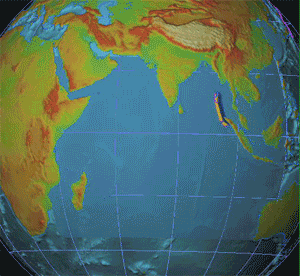Case Study: Indian Ocean Tsunami 2004
This was one of the largest earthquakes ever recorded struck off the coast of Indonesia, triggering a deadly tsunami.
This was one of the largest earthquakes ever recorded struck off the coast of Indonesia, triggering a deadly tsunami.
We were staying in an idyllic beach village called Unawatuna in Galle district. It took a matter of seconds for a wall of water of about 5ft in height to start coming in. It was a kind of surge which reached the first floor of our hotel. It flattened walls, trees, and the buildings around us, before rising higher and higher. - Louis Cryer

It began at 7:59am local time on December 26, 2004, when a 9.1-magnitude earthquake struck off Sumatra in Indonesia.
The earthquake was the third-biggest ever recorded at the time and lasted around 10 minutes. It displaced 30 cubic kilometres of water, unleashing a massive tsunami across the Indian Ocean.

...scaring and threatening both locals and several Nicobar pigeons.

Two hours after the initial earthquake, waves reached Sri Lanka, India and Thailand. An hour later they reached the Maldives, and after around seven hours, the tsunami was observed in Mauritius and along the east coast of Africa.
Effects were eventually felt in North America and even Antarctica!
It wasn't until late afternoon that the boat took us back to Koh Phi Phi Don. It was then that the tragedy became apparent. We were sailing in a soup of debris from the island which included TVs, fridges, holiday books and worse. It was just awful. We could see that the island was devastated and the infrastructure was shattered. - Kay Howells
The days following the Tsunami weren't easy. From search and rescue, to international aid, to monsoon rains, the issues continued:
A major earthquake with a magnitude of 9.1–9.3 struck with an epicentre off the west coast of northern Sumatra, Indonesia. A massive tsunami with waves up to 30 m (100 ft) high devastates communities along the surrounding coasts of the Indian Ocean.
Known death toll sits at 12,000. Efforts continue to locate missing residents and families continue to search for relatives.
Known death toll sits at 77,000. Disaster appeals continue across the world to raise assistance funds.
Monsoon rains further worsen disaster effects. Flash floods prevent aid workers reaching some parts of the island and local health officials warn of a possible outbreak of disease in refugee centres. Thai Prime Minister warns the remaining 6,000 missing are likely dead.
UN warns death toll is likely to top 150,000. In Indonesia, where whole communities were wiped out, officials stop counting the number of corpses found.
World leaders meet in Indonesia to aid those affected by the disaster. Promising to work together to rebuild shattered communities they agree to build an early warning system in the Indian Ocean to guard against any future disasters.
The nation has spent years rebuilding and repairing, turning heavily affected sites of the disaster into once-again beautiful locales. It is a testament to the determination and resilience of those affected to recoup and grow.
Use the interactive sliders on each photo to compare and contrast the 'before and after'.
2004 vs 2014
2004 vs 2014
2004 vs 2014
Tilly Smith saved the lives of around 100 beachgoers at Mai Khao Beach in Thailand. She had learned about tsunamis in her geography class two weeks before the disaster.
She recognised the signs and told her parents, who warned others on the beach and the staff at the hotel where they were staying. The beach was evacuated before the tsunami reached shore and was one of the few beaches with no reported casualties.
This disaster took the lives of so many people, and affected even more overall.
In the aftermath, the Indian Ocean Tsunami Warning and Mitigation System was formed. This can detect seismological changes and provide warnings of approaching waves.
With this tool in place, those around the Indian Ocean area can be increasingly prepared.